Typhoo Tea Homes of Famous Men
Issued in 1934 in the UK, the Homes of Famous Men 25-card set of Typhoo tea cards features portraits of famous authors, poets, inventors and more like Charles Darwin, Charles Dickens, William Shakespeare, Lord Byron and Robert Burns. The front of each card also includes a short bio of the historical figure and information about his home. The back of each card contains an advertisement for “Typhoo’s” New Vacuum Fountain Pen. The Home of Famous Men tea cards are still popular collector’s items.

No. 1 – ADMIRAL BLAKE’S BIRTHPLACE AT BRIDGEWATER, SOMERSET (NOW PRESERVED AS A MUSEUM)
This famous admiral was known as the “General of the Sea.” As a merchant he went to sea and learned sufficient about ships to take command of the Navy in 1649, after the Civil War. He defeated the Dutch and the Spaniards, and is considered to have laid the foundation of British naval supremacy. Portrait by courtesy of The British Museum.
No. 2 – COTTAGE AT ALLOWAY, AYRSHIRE, BIRTHPLACE OF ROBERT BURNS
Robert Burns, who wrote Auld Lang Syne, was one of the finest song-writers in the world and the greatest of Scottish poets. Born in 1759, the hard-working country boy studied at night the national ballads and legends which he later came to express so beautifully. He died young, poor and little appreciated in 1796. Portrait by courtesy of The National Portrait Gallery.

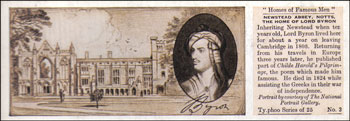
No. 3 – NEWSTEAD ABBEY, NOTTS, THE HOME OF LORD BYRON
Inheriting Newstead when ten years old, Lord Byron lived here for about a year on leaving Cambridge in 1808. Returning from his travels in Europe three years later, he published part of Childe Harold’s Pilgrimage, the poem which made him famous. He died in 1824 while assisting the Greeks in their war or independence. Portrait by courtesy of The National Portrait Gallery.
No. 5 – HALL-I’TH’-WOOD, BOLTON, HOME OF SAMUEL CROMPTON
Born in 1753, Samuel Crompton was five years old when his family moved to this house, their home for thirty years. Here the young inventor worked and perfected the Spinning Mule, which made possible in this country the weaving of fine cotton fabrics such as muslin. The house is now a folk museum. Portrait by courtesy of the Bolton Museums.
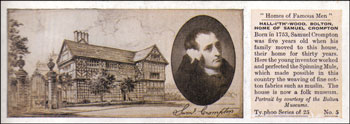

No. 6 – DOWN, FARNBOROUGH, KENT, THE HOME OF CHARLES DARWIN
Three years after his marriage in 1839, Charles Darwin, who was already famous, moved from London to the house shown in our picture. From the first the great scientist regarded Down as his home for life. Here for forty years he studied and wrote the Origin of Species and other works which made his name famous throughout the world. Portrait by courtesy of the National Portrait Gallery.
No. 7 – GADSHILL PLACE, NEAR ROCHESTER, THE HOME OF CHARLES DICKENS
In 1856, when the great novelist was writing Little Dorrit, he bought Gadshill Place, thus fulfilling an ambition cherished since boyhood’s days at Rochester. He became very fond of it and made it his permanent home, spending many of the last years of his life beautifying his garden. He died here in 1870. Photograph, Rischgitz Collection.

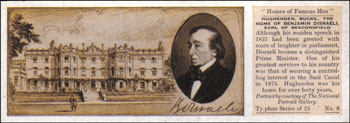
No. 8 – HUGHENDEN, BUCKS, THE HOME OF BENJAMIN DISRAELI, EARL OF BEACONSFIELD
Although his maiden speech in 1837 had been greeted with roars of laughter in parliament, Disraeli became a distinguish Prime Minister. One of his greatest services to his country was that of securing a controlling interest in the Suez Canal in 1875. Hughenden was his home for over forty years. Portrait by courtesy of The National Portrait Gallery.
No. 9 – HAWARDEN, FLINTSHIRE, THE HOME OF W. E. GLADSTONE
William Ewart Gladstone, statesman, orator, author and long famous as the “G.O.M.,” was one of the outstanding figures of 19th century politics. His reforms established almost universal suffrage, and he sought to establish almost universal suffrage, and he sought to establish Home Rule in Ireland. Often in his busy life he referred to the library at Hawarden as his “Temple of Peace.” Portrait by courtesy of The National Gallery.

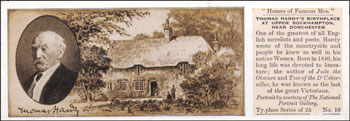
No. 10 – THOMAS HARDY’S BIRTHPLACE AT UPPER BOCKHAMPTON NEAR DORCHESTER
One of the greatest of all English novelists and poets, hardy wrote of the countryside and people he knew so well in his native Wessex. Born in 1840, his long life was devoted to literature; the author of Jude the Obscure and Tess of the D’Urbervilles, he was known as the last of the great Victorians. Portrait by courtesy of The National Portrait Gallery.
No. 12 – LAWN BANK, KEATS GROVE, HAMPSTEAD, THE HOME OF JOHN KEATS
Although he died in 1821 at the age of twenty-five, the poet whose Endymion begins – “A thing of beauty is a joy for ever” wrote lines which will last as long as the language. His perfect odes are unapproached in literature, and one of the most famous, the Ode to a Nightingale, was written in this house. Portrait by courtesy of the National Portrait Gallery.


No. 13 – JOHN KNOX’S HOUSE, HIGH STREET, EDINBURGH
One of the few remaining 16th century houses in Edinburgh, this is generally considered to have been the home of the great reformer and historian who established Protestantism in Scotland. His famous sermons were preached from the pulpit of St. Giles, Edinburgh. Portrait by courtesy of The British Museum.
No. 14 – MILTON’S COTTAGE AT CHALFONT ST. GILES, BUCKS
This is the only house connected with John Milton which still exists. The poet, who had been blind for over ten years, retired here in 1665 to escape the Great Plague. While here he lent the manuscript of Paradise Lost to his friend Ellwood, whose remarks led to the writing some years later, of Paradise Regained. Portrait by courtesy of The National Portrait Gallery.
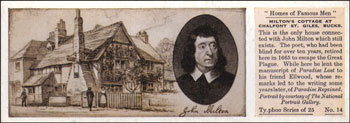

No. 15 – WOOLSTHORPE MANOR, NEAR GRANTHAM, THE BIRTHPLACE OF SIR ISAAC NEWTON
Driven from Cambridge by the plague in 1665, it was while sitting alone in this garden that the idea of universal gravitation occurred to the young Isaac Newton – the result, it is said, of seeing an apple fall to the ground. Later in life he elaborated this discovery into his famous law. Portrait by courtesy of The National Portrait Gallery.
No. 16 – PITT HOUSE, NORTH END, HAMPSTEAD, THE HOME OF THE EARL OF CHATHAM
William Pitt, the great Whig statesman who was known as “The Greatest Commoner,” had already become Earl of Chatham when he lived here in 1776-7. One of the greatest orators ever known, Pitt will be remembered chiefly for his work in consolidating the Empire. Portrait by courtesy of the National Portrait Gallery.
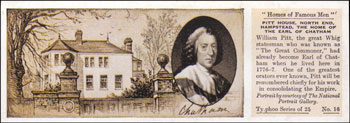

No. 17 – ABBOTSFORD, ROSBURGH, THE HOME OF SIR WALTER SCOTT
The author of The Lady of the Lake lavished much loving care on this beautiful home by the Tweed side. Here the great Scottish novelist and poet wrote most of the Waverley novels, and although his literary output was prodigious, he entertained many of the most famous people of his time. Portrait by courtesy of The National Portrait Gallery.
No. 18 – SHAKESPEARE’S BIRTHPLACE, STRATFORD-ON-AVLON
England’s greatest poet and dramatist! This was one of the most famous and best-known birthplaces in the world – indeed, it is referred to simply as The “Birthplace.” This little house at Stratford probably attracts more visitors than any other in the country. Bought for the nation in 1847, it was carefully restored ten years later. Portrait by courtesy of The National Portrait Gallery.
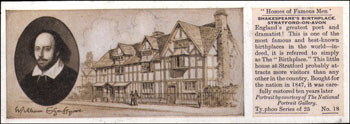

No. 20 – SOMERSBY RECTORY, LINCS., BIRTHPLACE OF ALFRED, LORD TENNYSON
Poet Laureate for over forty years, Tennyson spent most of his youth at Somersby where his father was rector. He evinced the poetic gift when quite young. In after years his early work brought a great reward, for the author of In Memoriam became the most popular poet of the 19th century. Portrait by courtesy of The National Portrait Gallery.
No. 21 – 16 YOUNG STREET, KENSINGTON, THE HOME OF W. M. THACKERAY
The great Victorian writer was already famous as an artist and “Punch” humorist when, in 1846, he took this house which was his home for several years. Here he lived happily with his daughters, writing Pendennis and Vanity Fair, which at once placed Thackeray in the front rank of English novelists. Portrait by courtesy of The National Portrait Gallery.

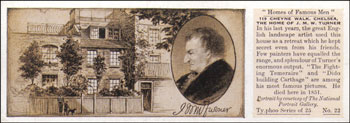
No. 22 – 119 CHEYNE WALK, CHELSEA, THE HOME OF J.M.W. TURNER
In his last years, the great English landscape artist used his house as a retreat which he kept secret even from his friends. Few painters have equaled the range, and splendour of Turner’s enormous output. “The Fighting Temeraire” and Dido building Carthage” are among his most famous pictures. He died here in 1851. Portrait by courtesy of The National Portrait Gallery.
No. 23 – APSLEY HOUSE, HYDE PARK CORNER, THE HOME OF THE DUKE OF WELLINGTON
Originally built for Lord Chancelor Apsley, this house was afterwards purchased by the famous soldier. His services in India and Spain, his military genius and his strong sense of duty earned his title of “The Iron Duke.” In 1815 he led the armies of England and Prussia to victory over Napoleon at Waterloo. Portrait by courtesy of The National Portrait Gallery.


No. 24 – MACARTNEY HOUSE, BLACKHEATH, THE HOME OF GEN. WOLFE
From his house Maj.-Gen. James Wolfe, then about thirty-two years old, set out to direct operations in Pitt’s expedition for the conquest of Canada. A tablet on the house reads “James Wolfe, 1727-1759, Victor of Quebec, Lived Here.” His masterly strategy and courage won Quebec but the battle cost him his life. Portrait by courtesy of The National Portrait Gallery.
No. 25 – THE OLD COURT HOUSE, HAMPTON COURT, THE HOME OF SIR CHIRSTOPHER WREN
The great architect of St. Paul’s in his latter years lived at the Old Court house, a Tudor mansion which he rebuilt. After the Great Fire of London in 1666, Sir Christopher Wren designed fifty churches, and many public buildings, but his scheme for replanning the city was unfortunately not adopted. Portrait by courtesy of The National Portrait Gallery.

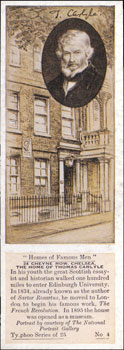
No. 4 – 24 CHEYNE ROW, CHELSEA, THE HOME OF THOMAS CARLYLE
In his youth the great Scottish essayist and historian walked one hundred miles to enter Edinburgh University. In 1834, already known as the author of Sartor Resartus, he moved to London to begin his famous work, The French Revolution. In 1895 the house was opened as a museum. Portrait by courtesy of The National Portrait Gallery.

No. 11 – DR. JOHNSON’S HOUSE IN GOUGH SQUARE, OFF FLEET STREET
This house was the home of the famous dictionary compiler from 1749-59, and much of the work on his great dictionary was done here. The author of Rasselas and Lives of the Poets was a great conversationalist, with a distinguished circle of friends. Many of his brilliant sayings were recorded by his biographer Boswell. Portrait by courtesy of The National Gallery.

No. 19 – 17 HERIOT ROW, EDINBURGH, THE HOME OF ROBERT LOUIS STEVENSON
From the age of seven until is father’s death in 1887, this house was the Edinburgh home of “R.L.S.,” the famous Scottish novelist, essayist, poet and traveler. Here young Robert showed early promise of the great gifts which in later years produced such works as Treasure Island. Portrait by The National Portrait Gallery.
